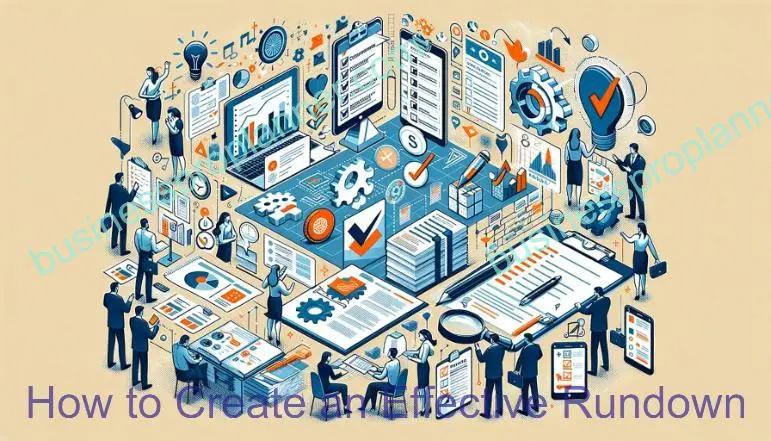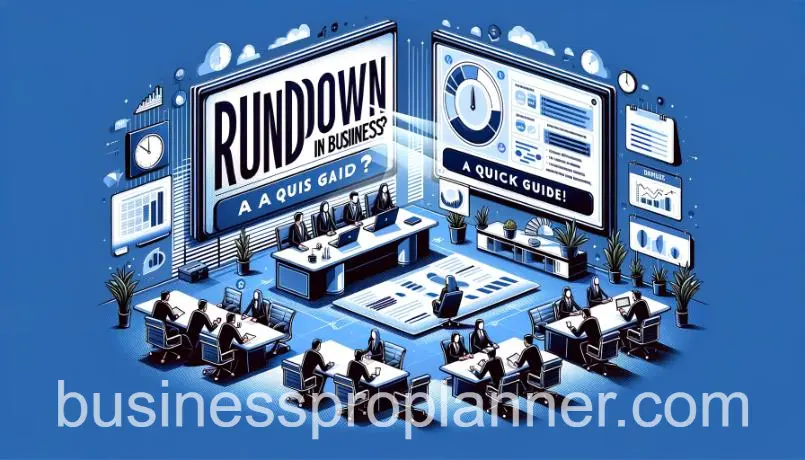A rundown is a handy organizational tool that provides a high-level overview of key information related to a client, project, event, or other business endeavor. An effective rundown ensures all stakeholders are on the same page and have the details they need to communicate efficiently and drive success.
Key Takeaways
- A rundown is a summarized list of pertinent details about a client, project, event, etc.
- Rundowns boost sales, streamline communication, prevent missed information, and keep everyone organized.
- Include relevant high-level information without unnecessary specifics.
- Maintain an easy-to-scan structure with clear sections.
- Store finalized rundowns in CRM folders for ongoing access and review.
- Update rundowns frequently as new information develops.
- Evaluate and refine your rundown approach to maximize results.
Understanding what a rundown is and learning how to create effective rundowns can immensely benefit your business. This comprehensive guide will dive into all aspects of crafting powerful rundowns that deliver results.
What Exactly is a Rundown?
A rundown is a summarized list or outline that provides an overview of key details of a particular client, project, event, product launch, or other business activity.
Rundowns serve as an at-a-glance reference document that compiles the most pertinent information into one place. They allow you to easily see the big picture rather than having to dig through extensive emails, notes, or files.

Some examples of rundowns include:
- Sales Rundowns: Summarize client needs, contact info, product details, pricing, and next steps.
- Project Rundowns: Outline project scope, timeline, team members, requirements, risks, and status.
- Event Rundowns: List event logistics, schedule, speakers, A/V needs, and other specifics.
- Product Launch Rundowns: Provide an overview of launch goals, marketing strategies, assets, and more.
The term rundown refers to “running down” or listing out the key details in a concise, organized way. The goal is to provide a helpful at-a-glance reference, not exhaustive documentation.
Benefits of Using Rundowns in Business
Implementing the practice of creating rundowns offers many benefits that can significantly impact business success:
Increased Organization and Alignment
- Compiles all key information in one place for easy access.
- Gets everyone up to speed on the details quickly.
- Ensures everyone involved is on the same page.
Streamlined Communication and Productivity
- Prevents duplication of work finding and gathering info.
- Minimizes backtracking through old emails and files.
- Enables pivoting seamlessly when priorities or details change.
Boosted Sales Results
- Outlines customer needs clearly for more effective nurturing.
- Highlights must-have product features and benefits.
- Keeps all details top of mind to close more deals.
Enhanced Client Service
- Summarizes customer history and preferences quickly.
- Reminds salespeople what matters most to each client.
- Provides instant access to previous interactions and activity.
Preventing Missed Information
- Reduces the likelihood of forgetting important details.
- Jogs memory before client calls and meetings.
- Highlights potential pitfalls or pain points to address.
In summary, rundowns are an invaluable tool for improving communication, productivity, sales, client service, and overall efficiency across nearly all business functions.
How to Create an Effective Rundown: Step-by-Step
Follow these best practices when creating rundowns to maximize their impact:

Determine the Purpose and Type
- Identify the core goal and subject of the rundown. Is it for a sales opportunity, project, event, launch, etc?
- This dictates what high-level information is most relevant to include.
Compile Pertinent Details
- Gather key information without including unnecessary minutiae.
- Focus on summarizing “need to know” data.
- Use existing assets like CRM records and project plans to extract details.
Maintain an Easy-to-Scan Structure
- Organize the rundown using simple sections and headings.
- Bullet points, tables, and lists allow users to scan quickly.
- Include contact information prominently at the top.
Leverage Templates and Examples
- Start with a template from your CRM system or internal docs.
- Review examples of effective past rundowns.
- Customize the format as needed for your situation.
Update the Rundown Frequently
- As details change, immediately update the rundown.
- Store previous versions to maintain a record of progress.
- Set calendar reminders to review and refresh regularly.
Share with All Relevant Parties
- Distribute the latest rundown via a centralized digital workspace.
- Collaborate and update documents together in real-time.
- Ensure everyone is working from the same latest version.
By keeping rundowns organized, succinct, updated, and shared, you enable your team to stay aligned and operate more productively.
Optimizing and Using Your Rundowns
To fully leverage rundowns for sales, service, productivity, and communication, be sure to:
Store Finalized Rundowns for Quick Access
- Save official rundowns in relevant CRM folders, groups, or project areas.
- Avoid searching through emails, chats, or notebooks.
Review Rundowns Before Calls, Meetings and Events
- Briefly review the rundown beforehand to refresh your memory.
- Identify any agenda items to focus on.
Make Real-Time Adjustments as Needed
- If any details change at the last minute, update the rundown accordingly.
- Rundowns reduce scrambling by enabling quick pivots.
Evaluate and Refine Your Rundown Process
- Identify what information drives the best results.
- Eliminate non-essential details that create clutter.
- Continually optimize the format for greater impact.
By integrating rundowns into your workflows before key activities and measuring outcomes, you can maximize the value delivered by enhancing organization, communication, and productivity across all business functions.
Rundown Templates and Examples
To help create effective rundowns tailored to various business needs, here are some templates and examples to follow:
Sales Rundown Template
- Client Profile
- Contact info, role, background
- Needs and Pain Points
- Product/Service Fit
- Pricing and Budget
- Potential Risks or Blockers
- Next Steps and Owner
Project Rundown Example
Project Phoenix Rundown
- Goals: Increase conversion rate by 2%, shorten sales cycle
- Scope: Redesign checkout flow, develop recommendations engine
- Timeline: 9/1 kickoff – 11/15 launch
- Team: Tom (PM), Lisa (Engineer), Jordan (Designer)
- Status: Designs approved, development in progress
Event Rundown Template
- Event Overview
- Name, date, location, purpose
- Agenda and Timing
- Attendee Profiles
- Speakers and Programming
- A/V and Tech Requirements
- Staffing and Roles
- Venue Logistics
- Promotion Strategy
- Contingency Plans
Leverage templates like these, adjust to your needs and refine over time to create rundowns that help drive business success.
How to Keep a Rundown Effective
Establishing a preliminary rundown structure is crucial, yet its continuous refinement is essential to maintain its accuracy and effectiveness as a business tool over time.
- Assign Updates: Responsibilities for updating each section need to be clearly defined so information stays current.
- Set Review Cadence: Scheduled reviews, like weekly or monthly standups, catch any overlooked changes and keep distributed teams coordinated.
- Integrate with Systems: Automated synchronizing eliminates manual data entry while linking to source systems for drill-downs.
- Refine Format Based on Use: As workflows evolve, solicit feedback to refine formats, fields, and views for ongoing optimization.
- Establish Guidelines: Clear best practices like standard naming, formatting, and documentation styles maintain usability across users.
- Consolidate Files: Too many disjointed rundown documents defeat the purpose; regularly consolidate the info to a master centralized file or hub for a ‘single source of truth’.
- Leverage Templates: Standardized templates customized for each different context or team speed up updates and simplify onboarding new users.
- Consider Access Controls. For sensitive client or sales data, customize permissions to ensure the security of commercially sensitive or private information.
With prudent maintenance, your rundown remains a dynamic business tool rather than a one-time project.

Conclusion
Adopting rundowns significantly boosts business efficiency, sales, and overall success. These tools compile crucial information on clients, projects, and events in one spot, enhancing team unity, communication, and focus. This approach cuts down on time spent hunting for data, making teamwork smoother and more flexible.
Rundowns shine in improving sales by spotlighting customer needs, product details, and key talking points, leading to more deal closures. They’re easily accessible, stored in CRM systems, and continuously improved. This method boosts work efficiency, client interaction, and profits.
Committing to rundowns provides a competitive advantage. It involves crafting detailed summaries, reviewing them before important meetings, and refining their use. This ensures organizational alignment and excellence in execution.
I urge all businesses to embrace rundowns as a straightforward method to consolidate essential data, streamline operations, and elevate sales outcomes.
Muhammad Asif Saeed has extensive experience in commerce and finance. Specifically, He holds a Bachelor of Commerce degree specializing in Accounts and Finance and an MBA focusing on Marketing. These qualifications underpin his understanding of business dynamics and financial strategies.
With an impressive 20-year career in Pakistan’s textile sector, including roles at Masood Textile (MTM) and Sadaqat Limited, excelling in business & financial management. His expertise in financial and business management is further evidenced by his authoritative articles on complex finance and business operation topics for various renowned websites including businessproplanner.com,businesprotips.com,distinctionbetween.com, trueqube.com, and bruitly.com, demonstrating his comprehensive knowledge and professional expertise in the field.
